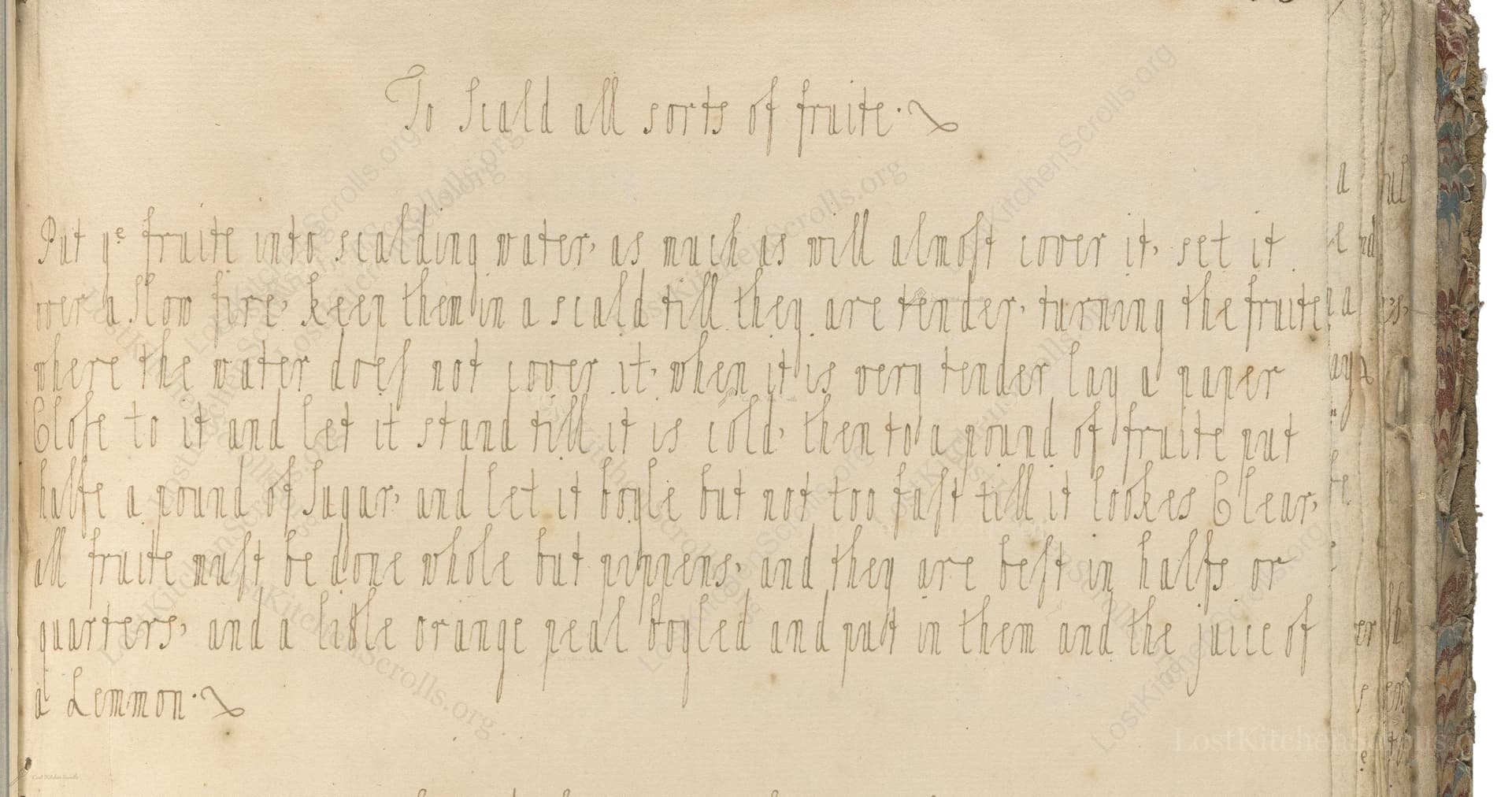To Scald All Sorts Of Fruite
From the treasured pages of Cookbook of Mary Puleston
Written by Mary Puleston

To Scald All Sorts Of Fruite
"Put ye fruite into scalding water as much as will almost cover it. set it over a slow fire. keepe them in a scald till they are tender turning the fruite where the water does not cover it: when it is very tender lay a paper close to it and let it stand till it is cold. then to a pound of fruite put halfe a pound of sugar and let it boyle but not too fast till it lookes clear. all fruite must be done whole but pippins, and they are best in halfs or quarters. and a litle orange peall boyled and put in them and the juice of a Lemmon."
Note on the Original Text
As was common in manuscripts of the time, the recipe assumes the reader’s practical knowledge, omits precise quantities for fruit, and writes in narrative rather than instructional style. Spellings such as 'boyle', 'fruite', and 'peall' are period-standard; 'pippins' specifically refers to certain types of apples historically valued for preserves. The use of a paper barrier as a cooling cover was a technique to prevent oxidation and contamination before modern food wraps. The method exemplifies the blend of culinary intuition and resourcefulness that marked domestic English cookery of the period.

Title
Cookbook of Mary Puleston (1764)
You can also click the book image above to peruse the original tome
Writer
Mary Puleston
Era
1764
Publisher
Unknown
Background
A tantalizing compilation of 18th-century culinary wisdom, this collection artfully preserves the flavors, techniques, and charms of British cookery before 1764—inviting modern gourmets to savor a taste of history with every recipe.
Kindly made available by
Folger Shakespeare Library
This recipe comes from the handwritten collection of Mary Puleston, a domestic English compiler who died in 1764. The recipe predates her death, situating it in the culinary landscape of mid-18th-century Britain, when sugar was still a relatively expensive ingredient and fruit preservation was both an art and necessity. Recipes like this balanced the desire for year-round enjoyment of fruit with the technical skills required to keep it from spoiling. The addition of citrus, increasingly fashionable thanks to greater import in the 1700s, adds both flavor and a measure of acidity for preservation.

In the 18th century, this recipe would have been made using a hearth or range with a moderate, controllable fire, a sturdy metal or copper preserving pan, a wooden spoon or spatula for gently turning the fruit, and cloth or paper to keep the fruit covered as it cooled. Scalding was typically done in heavy-bottomed pans, and careful attention was paid to not letting fruits break apart. Scales or weights would be used to measure sugar and fruit—a practice already established at the time for accuracy in preserving.
Prep Time
10 mins
Cook Time
30 mins
Servings
4
We've done our best to adapt this historical recipe for modern kitchens, but some details may still need refinement. We warmly welcome feedback from fellow cooks and culinary historians — your insights support the entire community!
Ingredients
- 1 lb assorted whole fruit (apples, pears, plums, apricots, cherries, etc.)
- 8 oz granulated sugar
- 1 small piece (about 0.2 oz) orange peel (use zest if unavailable; bitter orange preferred but sweet is acceptable)
- Juice of 1 lemon (approx. 1 fl oz)
- Water as needed
Instructions
- Begin by placing your chosen whole fruit (apples, pears, plums, apricots, cherries, or other suitable varieties) in a saucepan.
- Pour in enough boiling water to almost cover the fruit.
- Over a low to medium heat, gently simmer the fruit, turning any pieces not covered by water, until they are just tender—this may take 10-20 minutes depending on the fruit’s firmness.
- Once tender, drain and lay the fruit in a bowl, pressing a piece of parchment paper directly against the surface.
- Let it cool completely.
- Weigh the cooked fruit and add half as much granulated sugar by weight (for example, 1 lb fruit to 8 oz sugar).
- Return both to the cleaned saucepan.
- Bring to a gentle boil—do not let it boil too rapidly—until the fruit looks clear and slightly glossy, about 10-20 minutes.
- For added flavor, boil a strip of orange peel separately and add it in along with the juice of one lemon.
- For apples (pippins), it is best to cut them in halves or quarters before cooking.
Estimated Calories
160 per serving
Cooking Estimates
You will spend about 10 minutes getting your fruit and other ingredients ready, and about 30 minutes cooking everything until the fruit is tender and glossy. Each serving is about 160 calories, based on 4 equal portions.
As noted above, we have made our best effort to translate and adapt this historical recipe for modern kitchens, taking into account ingredients nowadays, cooking techniques, measurements, and so on. However, historical recipes often contain assumptions that require interpretation.
We'd love for anyone to help improve these adaptations. Community contributions are highly welcome. If you have suggestions, corrections, or cooking tips based on your experience with this recipe, please share them below.
Join the Discussion
Rate This Recipe
Dietary Preference
Main Ingredients
Culinary Technique

Den Bockfisch In Einer Fleisch Suppen Zu Kochen
This recipe hails from a German manuscript cookbook compiled in 1696, a time whe...

Die Grieß Nudlen Zumachen
This recipe comes from a rather mysterious manuscript cookbook, penned anonymous...

Ein Boudain
This recipe comes from an anonymous German-language manuscript cookbook from 169...

Ein Gesaltzen Citroni
This recipe, dating from 1696, comes from an extensive anonymous German cookbook...
Browse our complete collection of time-honored recipes



